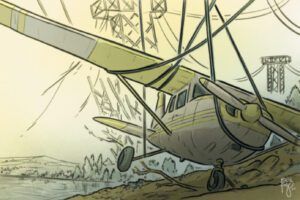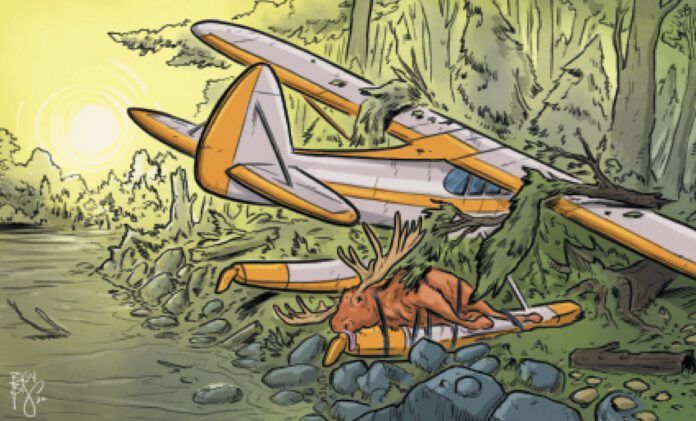Yes, we’d done as we were told. The hushed voice on the phone had promised a copy the 2019 Golden File from the Official Office of Plane Safety (OOPS)—the nearly magical file that contained that august organization’s conclusions as to which nonfatal aircraft accidents were the result of the most boneheaded moves by people who professed to be pilots.
It was midnight, the time prescribed for the handoff. Guided by the light of a full moon, we’d found the hole in the perimeter fence, entered the aircraft boneyard, and located the designated fuselage—all that remained of a pranged Cessna Caravan. Crouching, we passed through the cargo door and, in the moonlight, saw a bent Piper Cherokee control yoke lying on the floor. Following instructions, we deposited the agreed upon payment, a copy of James Gilbert’s classic, The World’s Worst Aircraft beside the yoke.
There must have been a camera aimed at the spot because the instant we let go of the book, a tinny voice rattled harshly from a speaker lying just aft of the yoke, “Leave it there. Turn right and move forward. The folder is in the pouch on the back of the pilot’s seat. Take it and get out.”
We complied. Once outside the boneyard we snapped on a flashlight, opened the folder, and found the motherlode of NTSB reports culled by OOPS, another tribute to the organization’s motto, “Will doing this make me look stupid in the NTSB report?” We immediately started reading.
Social Media, Flight Safety
The pilot of an Eipper Quicksilver decided to take a photo of himself in full heroic flight rather low offshore over the Atlantic Ocean. In the process of positioning his cell phone and posing, he moved the fuel shutoff switch to “off.” Following the subsequent ditching he was fished out by boaters. The NTSB report did not mention whether he posted the selfie.
Takeoff Trauma
The pilot reported that the initial taxi and engine run-up were normal. However, during the takeoff roll, the RV-6’s engine sputtered and he aborted the takeoff. After taxiing back, the pilot performed an engine run-up. All went well. Figuring that the engine had cured itself, our favorite optimist elected to launch. You can write this one. The engine ran just fine until 200 feet up, at which point it took the day off. The subsequent landing in a field substantially damaged the airplane.
That Moose Story…
After loading the Super Cub floatplane with a passenger and all the moose meat he could cram inside, the pilot started his takeoff run on the 750-foot-long Alaskan lake. At 40 MPH he snapped on two notches of flaps and the airplane lifted off—but wouldn’t climb out of ground (water?) effect.
Shortly after running out of lake, the right float and wing hit the ground and things came to a stop. The pilot gave two versions of the event, in one he said that he’d overloaded the airplane, in the other, he stated that the engine wasn’t putting out full power. There was no record of the passenger saying that they’d made it 200 feet further than they had last year.
If At First
Shortly after liftoff, the engine of the Beech 19 Musketeer transitioned abruptly from noisy to quiet. The pilot landed safely in a field adjacent to the runway. Once stopped, he realized that the fuel selector was in the “off” position. Selecting “on” and hitting the starter resulted in reciprocating noises up front, so the pilot decided to make a soft-field takeoff from where the airplane was happily idling.
During the takeoff roll, the airplane climbed an embankment and left the surly bonds of earth. Briefly. It touched down hard. Determined, the pilot carried on until the nosegear broke off and the fuel tanks ruptured leading to a fire that crispy-crittered the airplane.
Gotta Avoid the Pesky Runway
Loaded 300 pounds over gross and “heavy aft” with one of the seven occupants sitting on the floor, the pilot started the six-seat Piper PA-46 Malibu on its takeoff roll. Everything appeared “good” until he saw a yellow warning light illuminate. He remembered seeing the letters “hydr…” on the light and, despite being airborne, became concerned about the landing gear.
He decided to abort the takeoff, reduced power and held back pressure on the yoke. He then “intentionally let the airplane go left over the grass” rather than stay above the runway—despite seeing a taxiway sign ahead. The stall warning horn sounded.
Shortly thereafter the airplane landed on the taxiway sign. The pilot then pulled the yoke full aft and applied right brake, swerving the airplane into a ditch, which stopped anything else from going wrong.
Determined to Demo
 Fifty-seven pounds over its 1510-pound gross weight and out of C.G. limits, a pilot demonstrating a two-seat ICON A5 seaplane to a potential customer made three tries at takeoff before breaking free of rough water on a windy afternoon on Lake Michigan. Attempting to avoid even rougher water, the takeoff run was started close to shore directly toward tall trees.
Fifty-seven pounds over its 1510-pound gross weight and out of C.G. limits, a pilot demonstrating a two-seat ICON A5 seaplane to a potential customer made three tries at takeoff before breaking free of rough water on a windy afternoon on Lake Michigan. Attempting to avoid even rougher water, the takeoff run was started close to shore directly toward tall trees.
In what became a scary YouTube video (https://tinyurl.com/3a7advem), the airplane barely cleared the trees, at which point the demo pilot started a right turn. During the first 90 degrees of turn the nose slowly pitched up as the airplane slowly descended. At that point, the nose pitched down, the right wing hit a tree, the airplane started to rotate while the nose continued to pitch down until the seaplane impacted the water vertically.
Before demonstrating the joys of pilot-induced oscillations (PIO) on takeoff, the pilot of an A36 Bonanza reported that he “increased the trim” because the tail felt like it was “lifting ahead of the nose when not heavily loaded in the rear.” At 73 knots and 1800 feet down the runway, the airplane lifted off.
The pilot applied forward yoke pressure to increase the airspeed. This caused the airplane to return to the runway at 74 knots, just short of the overrun, bounce dramatically and pitch up. The pilot again pushed forward on the yoke “to level the airplane,” but the airplane touched down hard in the grass 155 feet beyond the end of the runway. Being the first point of impact, the nose landing gear promptly collapsed, terminating the PIO exercise.
Why Not Go Around?
The pilot of a Rockwell 690 Turbo Commander was having some trouble on his approach. At first, “the airspeed was high, so he decreased it.” He did not attempt to extend the landing gear until on short final, at which point he pushed down hard on the landing gear lever. No gear-in-transit noises ensued. Realizing that the gear had not extended and “due to the airplane’s proximity to the runway,” he decided to land the airplane with the gear retracted.
Later, with the airplane on jacks, the gear operated normally. Thinking about it subsequently, the pilot said that “he must have inadvertently pushed the gear lever to the side, which bound up the handle.”
Uh, Don’t Dump Those Flaps
The Maule MX-7 pilot reported that he performed three low passes and briefly touched down on the 750-foot grass runway to test the surface before conducting a full-stop landing. On landing, the airplane bounced and “veered right.” The pilot said that he attempted to correct using left rudder. He then heard what he said sounded like branches brushing against the right side of the airplane and decided to go around by applying full power and retracting the manual flaps.
Concerned that the now flaps-up airplane wasn’t lifting off and thus would not clear large bushes at the end of the runway, he pulled the power to idle and used left rudder to steer the airplane to the left of the bushes. Again, he didn’t apply enough left rudder and the airplane proceeded straight into those bushes.
Want Full Deflection with That?
Shooting a night ILS in ¼-mile visibility in a Cessna 172, the pilot saw full right deflection on the localizer needle. Apparently deciding that missed approaches were for other pilots, she kept on going and “corrected to the left,” (huh?), and then saw “full left” deflection “at about the decision altitude.” You got it—the pilot kept on going.
That decision was followed by a loud bang and the airplane turning left. That was finally enough for her to miss the approach. Climbing out, the pilot had a sudden attack of good sense, declared an emergency, diverted to an airport with better weather where a successful landing was accomplished, and pine needles were removed from the “substantially” damaged left wing.
It’s So Cool to Fly Low
After loading a passenger into the single-seat Air Tractor AT 602, the pilot made a “low-altitude application flight” over a gender-reveal party and dumped 350 gallons of pink water from the ag plane’s hopper. Looking back at the revelers, he stalled the airplane, hit the ground, and came to a stop inverted.
“low-altitude application flight” over a gender-reveal party and dumped 350 gallons of pink water from the ag plane’s hopper. Looking back at the revelers, he stalled the airplane, hit the ground, and came to a stop inverted.
Ya Think?
On a mission to spot bears, the pilot of the Aviat Husky was successful. He reported making “multiple low-altitude passes to maintain sight of the bears.” While maneuvering uphill at a low altitude, his attention was drawn to the bears and away from terrain. When he regained focus, he turned the airplane right, away from rising terrain. Good idea, but about 90 degrees into the turn, the nose pitched down and the airplane hit the ground. Following the accident the pilot stated that he should have let the observer observe the bears during the low passes.
I’m Going to Reposition Via…
Departing on what he described as a “repositioning flight,” the pilot of a Cessna 172 decided not to proceed directly to his destination nor climb high and risk hypoxia. The GPS data showed that the pilot followed a river at a “low altitude” for several miles, at some points as low as 30 feet AGL.
As the airplane approached a sharp bend in the river, the pilot appeared to experience a rapid onset of the smarts and climbed a few hundred feet. His moment of sanity proved fleeting as he then performed a left descending turn down to the river. He followed it for an additional 1.5 miles before smacking into power lines and coming to rest on a sandbar.
You Want to Turn Which Way?
After rolling out on a left base leg for landing, the pilot realized that he and his Sonex were higher than desired. Being creative and deciding that the regs calling for all turns in the pattern to be to the left was really just a guideline, he made a 270-degree right turn to final to burn off the excess altitude. To further help deal with the excess altitude issue he added 20 degrees of flaps. The plan worked better than expected. Sadly, he didn’t realize the extent of his plan’s success before flying into a tree.
Helpful Friend
Right after the PIC had successfully greased the Beech 55 Baron onto the runway, the pilot-rated passenger, without the PIC’s “permission or guidance,” smartly moved the landing gear lever to the “up” position. Despite the right-seater immediately moving the gear switch back to the “down” position, the gear had started to retract, and unceremoniously lowered the airplane to the runway. The pilot-rated passenger said he was trying to assist the pilot by raising the flaps during rollout. No record was made of the pilot’s comments during or after the CRM failure.
But … No Runway Lights
Flying with excellent intentions—proficiency and getting current at night—the Cessna 182 pilot misjudged his approach just a little. He touched down short of the runway and was stopped by the engineered materials arrestor system. He misjudged the approach by thiiisss much—his touchdown point was 370 feet below the threshold.
White Lights … Blue Lights
While on base leg on his third night landing attempt in a Glastar the pilot reported that the runway lights turned off. His attempts to turn the runway lights on again were not successful. Nevertheless, he pressed on with his approach, turning final at 200 feet AGL. Thinking fast, and not wanting to waste a potential chance to land by doing a go-around and taking time to sort out the runway light problem, he decided to use the blue taxiway lights parallel to the runway as his reference to land. Unfortunately, his idea didn’t work out as well as he hoped as he flew into a tree and then impacted the ground inverted.
And the Winner Is
On a lovely June day, the pilot was making a water landing in his Maule MX-7. All was going swimmingly until, shortly after touchdown, the pilot remembered that he hadn’t switched out the tundra tires for floats as he’d intended. As water entered the flight deck, the pilot made his exit and the airplane sank.
Rick Durden is a retired aviation attorney, CFII, holds an ATP, and is the author of The Thinking Pilot’s Flight Manual or, How to Survive Flying Little Airplanes and Have a Ball Doing It, Vols. 1 and 2.





